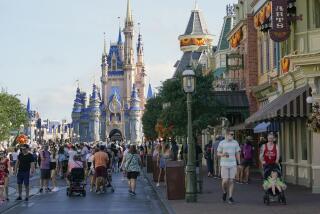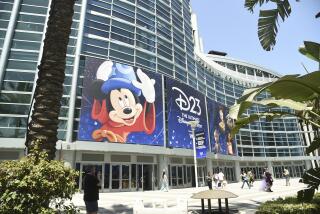Promotions Pay Off for Some Parks : Lower Ticket Prices, New Rides Helped Most Southland Attractions
- Share via
Six Flags Magic Mountain unveiled a classic wooden roller coaster. At Disneyland, Knotts Berry Farm and Universal Studios Hollywood, they cut ticket prices at the gate. Sea World offered a promotion that treated active military personnel to free admittance.
Across the Southland, amusement parks took special steps before the summer began to attract customers.Park officials feared that the recession and the lingering impact of the Persian Gulf War would discourage people from visiting their fantasy worlds.
Now, as the summer season comes to a close, Southland theme parks are assessing whether the measures paid off.
Park officials don’t release precise attendance or revenue figures, but for some the strategies appeared to work. Knotts Berry Farm, citing its lower children’s ticket prices and a new entertainment package, reported slightly higher attendance compared to last year. Disneyland also said it had slightly higher attendance despite the recession and unseasonably cool weather.
But for others, the predictions of a lackluster season came to pass. Entering the Labor Day weekend, summer attendance at Universal Studios is down slightly from last year, according to spokeswoman Joan Bullard. And San Diego’s Sea World, where about 40% of the guests are from outside Southern California, experienced a dip in paid attendance this summer and spending inside the park also was flat, spokesman Dan LeBlanc said.
During tight economic times, amusement parks often lower ticket prices, offer special package deals and open new attractions to attract a broader audience. Despite such efforts, a common denominator for many theme parks was a softer summer “than some of the parks would have hoped,” said James Harmon, a partner at the amusement park consulting firm Management Resources in Tustin.
Harmon said that before and during the summer months, “most talk has centered on the nebulous and somewhat hazy recession.” He added: “I don’t think any of the parks are surprised about the summer. . . . They went into the season with their eyes open.”
All theme parks in the competitive Southern California market rely to some degree on visitors from outside the local market, said Tom Powell, editor of Amusement Business magazine, a trade publication that tracks the health of the amusement park industry. But this summer, with the tourism ailing, many parks turned more attention to their own back yards, hoping to draw residents who chose a less expensive route by vacationing close to home.
Universal Studios announced in March a plan to cut ticket prices for California residents until May. Universal officials said the move attracted more locals, who continued to come in significant numbers even after prices were increased again. Bullard said a survey Monday showed that attendance from Californians was up 13% over a comparable day last year, even though total attendance has declined slightly for the entire summer.
Disneyland, which has not added a major attraction for two years, featured a “resident salute” from January until March, during which Southern Californians could buy a cut-rate ticket for $20, compared to the usual $27.50 for adults. Disneyland, like many other theme parks, does not release attendance figures, but publicist John McClintock said, “It has seen a healthy summer.”
For those parks that did not fare so well, it has been a long summer.
Blaming cooler weather and the state of the economy, Sea World’s LeBlanc said he did not believe that the water park would get a boost in attendance to offset declining revenues this year. He said the park was fortunate to have a large resident market from which to draw, but that even the locals were not helping much.
A soft tourist market, amusement park analysts say, has meant lasting problems for nearly every theme park, editor Powell said. “If tourism is down,” he said, “then (amusement parks) can’t make it up” over the rest of the year, even if they attract a larger share of the local market.
Even so, most analysts believe that the current slow period will improve with the economy and does not signal the beginning of a long-term drought for theme parks.
John Robinett of Economics Research Associates, a West Los Angeles consulting firm, said revenue for the region’s theme park industry has been increasing at an annual average rate of 3% to 5%, with attendance rising at about the same rate as well. And despite the intense competition among theme parks from San Diego to Los Angeles, Robinett said there still is plenty of room in the market for more players.
More to Read
Inside the business of entertainment
The Wide Shot brings you news, analysis and insights on everything from streaming wars to production — and what it all means for the future.
You may occasionally receive promotional content from the Los Angeles Times.










